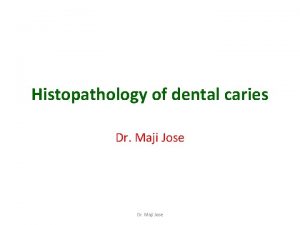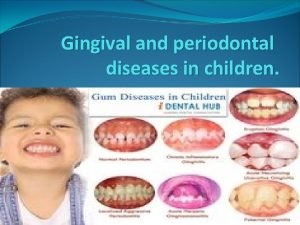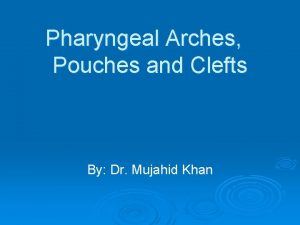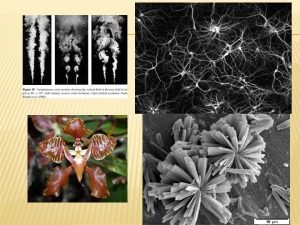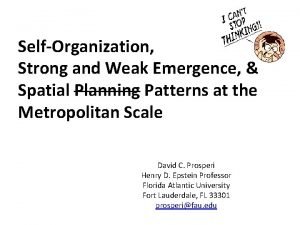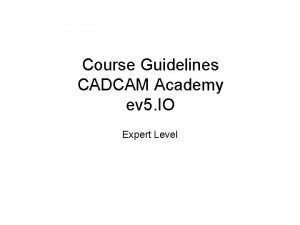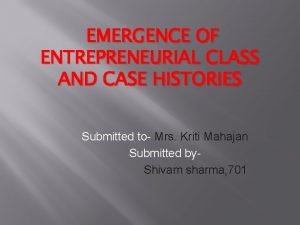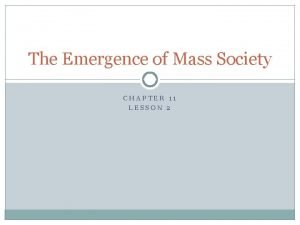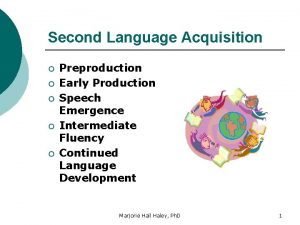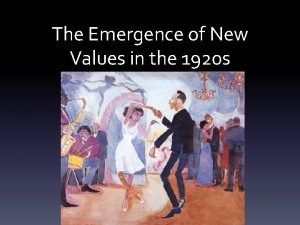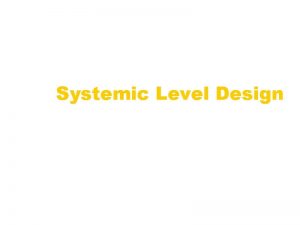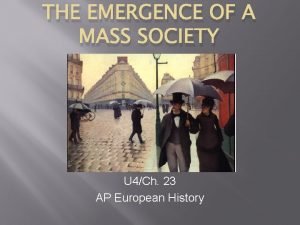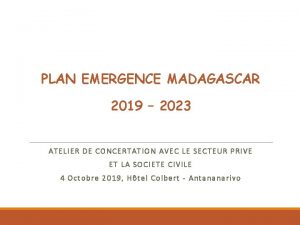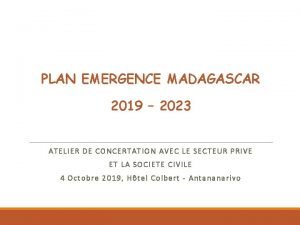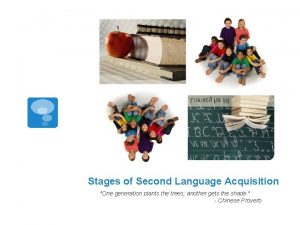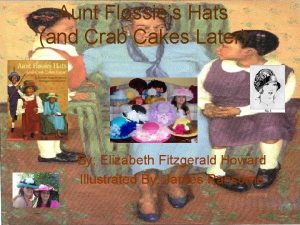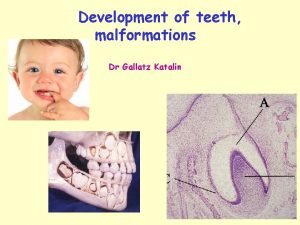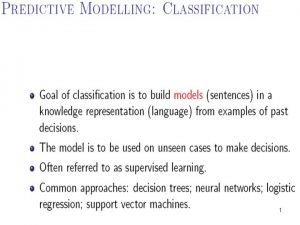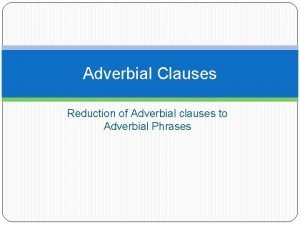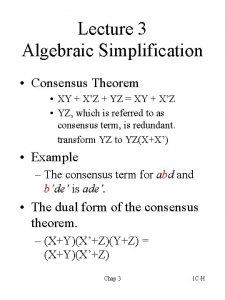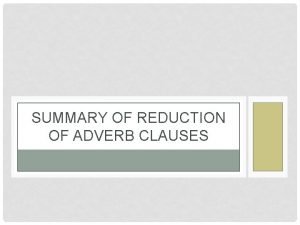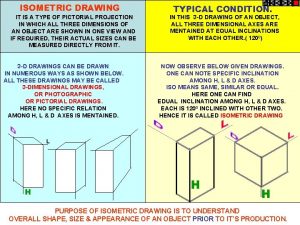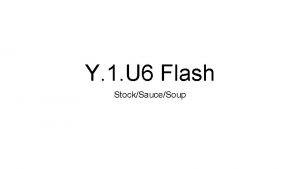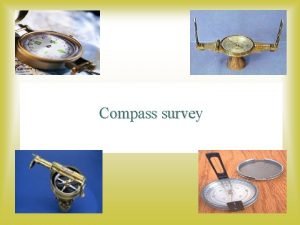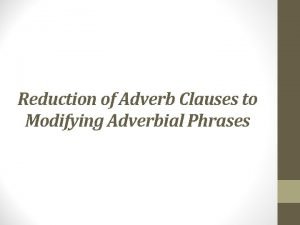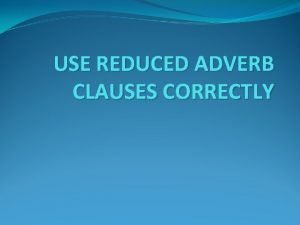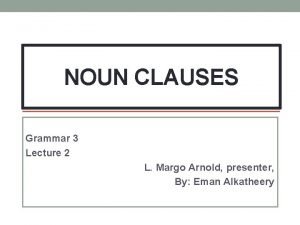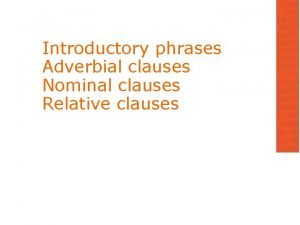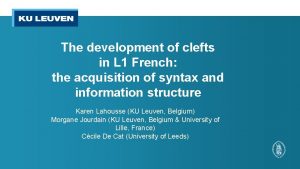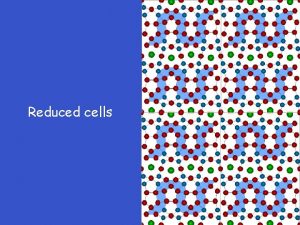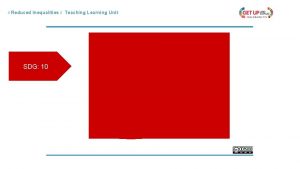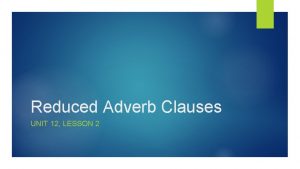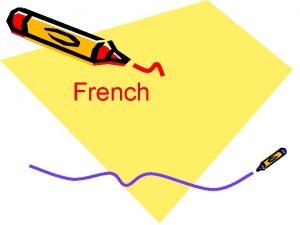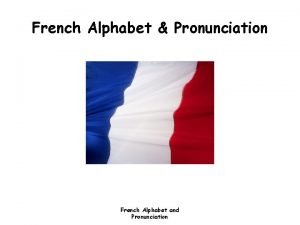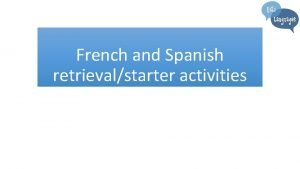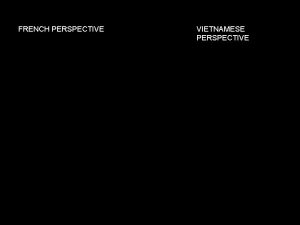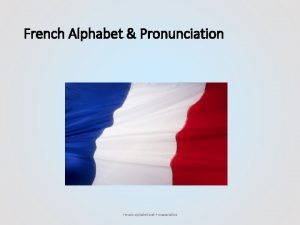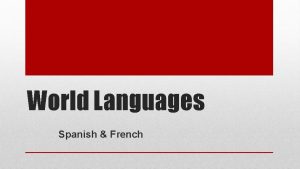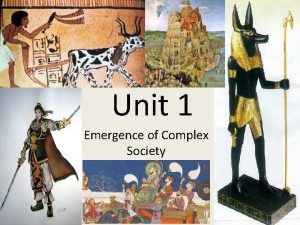The emergence of reduced full clefts in French



































































![*CHI: <pourquoi c'est> [//] pourquoi il s'est fait mal ? *MOT: ba [: *CHI: <pourquoi c'est> [//] pourquoi il s'est fait mal ? *MOT: ba [:](https://slidetodoc.com/presentation_image_h/993e7ad1c8777ce68f971fd9b45503da/image-68.jpg)











- Slides: 79

The emergence of (reduced & full) clefts in French L 1 Karen Lahousse (KU Leuven, Belgium) & Morgane Jourdain (KU Leuven, Belgium + University of Lille, France) Research seminar Geneva, 29/3/2019 Karen. lahousse@kuleuven. be

Project • Project “First Language Acquisition of Information Structure in French (FLAc. IS)” (Funded by Research Fund of KU Leuven) • Supervisor: Karen Lahousse; Co-supervisors: Emmanuelle Canut & Cécile De Cat • Ph. D student: Morgane Jourdain • Goal = compare acquisition of topic and focus in French L 1 o o o developmental study (in corpora of spontaneous speech) of clefts and CLLD in French L 1 • Website: https: //www. arts. kuleuven. be/ling/is-acquisition • End of April: Conference on the acquisition of Information Structure

Topic of this talk = early development of clefts in French L 1

Topic of this talk = early development of clefts in French L 1 (1) Adulte: Qui est-ce qui te l’a offert? ‘Who offered it to you? ’ Enfant: C’est Maya ‘It’s Maya’ (Héloïse, 2 ans, TCOF) REDUCED CLEFT

Topic of this talk = early development of clefts in French L 1 (1) Adulte: Qui est-ce qui te l’a offert? ‘Who offered it to you? ’ Enfant: C’est Maya ‘It’s Maya’ REDUCED CLEFT (Héloïse, 2 ans, TCOF) (2) Soeur: On le met comme ça d’accord? D’accord Anaïs? Sister: ‘We put it like this, OK? OK Anaïs? Anaïs: Non! C’est moi mets ‘No! It’s me put’ (Anaïs, 2 ans, Lyon) “CLEFT TRIAL” (not in previous work)

Topic of this talk = early development of clefts in French L 1 (1) Adulte: Qui est-ce qui te l’a offert? ‘Who offered it to you? ’ Enfant: C’est Maya ‘It’s Maya’ REDUCED CLEFT (Héloïse, 2 ans, TCOF) (2) Soeur: On le met comme ça d’accord? D’accord Anaïs? Sister: ‘We put it like this, OK? OK Anaïs? Anaïs: Non! C’est moi mets ‘No! It’s me put’ (Anaïs, 2 ans, Lyon) “CLEFT TRIAL” (not in previous work) (3) Child: yyy veux faire avec j(e) faire j(e) veux pas faire les tortues c'est compliqué ‘I don’t want to do the turtles, it’s complicated’ Adult: oui c'est un petit peu compliqué mais qu'est-ce qu'on peut faire d'autre ? ‘Yes it’s a bit complicated but what else can we do? ’ Child: c'est toi qui m(e) fait les tortues. (Marie, 2; 9) FULL CLEFT ‘it’s you who to me does the turtles’

Note • Previous examples = produced already at age 2 • => to study emergence of clefts, data from ages 1 & 2 are needed • Probably impossible in experiments

Literature on clefts in general C’est clefts in ADULT French (and other languages) have been EXTENSIVELY studied o o o spoken and written language different perspectives (syntax | information structure | semantics) different methodologies (native speaker intuitions | analysis of corpora of spontaneous speech | experiments) See references cited in Cruschina (2015), Belletti (2007, 2008, 2009, 2015), Lahousse & Borremans (2014), Lahousse, Laenzlinger, Soare (2014), Karssenberg & Lahousse (2018), Karssenberg (2018), Aravind et al. (2018).

Literature on clefts in general C’est clefts in ADULT French (and other languages) have been EXTENSIVELY studied o o o spoken and written language different perspectives (syntax | information structure | semantics) different methodologies (native speaker intuitions | analysis of corpora of spontaneous speech | experiments) See references cited in Cruschina (2015), Belletti (2007, 2008, 2009, 2015), Lahousse & Borremans (2014), Lahousse, Laenzlinger, Soare (2014), Karssenberg & Lahousse (2018), Karssenberg (2018), Aravind et al. (2018). FEW analyses of the EMERGENCE Of clefts in general Pivi, Del Puppo, Cardinaletti (2016): “observations from young children’s samples of spontaneous language have shown that clefts emerge around the age of 2” (Demuth 1984; Labelle 1990; Santos 2006)

Literature on the acquisition of clefts in French L 1 Hupet & Tilmant (1989) • Elicited production experiment / ages 4 – 10 • French children produce subject clefts more easily than object clefts, even at age 10 Labelle (1980, 1991, 1996): • 1 st relative clauses in French: inside cleft construction (see also Diessel & Tomasello 2005 on English) • Ages: 3 – 6 years De Cat (2002) • Observations in corpus of spontaneous production (ages 1 and older) • Some early attempts of reduced clefts = main clause + right dislocation (as from 1; 11) (4) Non c’est moi, (qui l’ai) le pingouin (Tom 2; 1. 11) • No systematic analysis

Literature on the acquisition of clefts in French L 1 Canut (2014) • Appearance and frequency with respect to other (complex) sentence types • C’est … qui / que … sentences appear at age 2, and increase in frequency until age 5 • But: o No distinction between clefts >< ‘cleft lookalikes’ (c’est + NP + restrictive relative clause) o No data on reduced clefts Belletti (2005) • Some examples of reduced clefts from Childes (as from age 2; 1) • Reduced clefts (as an answering strategy) “are in place early on, as soon as the first felicitous conversational exchanges can be documented”.

This talk in a nutshell • Developmental analysis of syntax of clefts (including the developmental path of the cleft relative clause = CRC) • On the basis of corpus analysis (longitudinal & transversal) = spontaneous production (ages 1 - 3) • Analysis of Syntax & Information Structure (IS) • Comparison with the emergence of CLLD in French

MAIN RESEARCH QUESTIONS & HYPOTHESES

I. Acquisition of syntax of clefts - i the syntax of clefts The development of the main clause (reduced cleft) and the CRC • Confirms previous literature (cf supra)? i. e. children first acquire c’est clause (reduced cleft) + add cleft relative clause (which they do not use in another context at that moment) • What’s the relation between full clefts and reduced clefts per age group? • What about the development of cleft trials? • Indications about the nature of the CRC? Is it a small clause with CP complement (see Belletti 2008, 2009)? • If a reduced cleft is a cleft with a deleted CP (zie Belletti 2008), what are the predictions for language acquisition? (I don’t have an answer to that. )

I. Acquisition of syntax of clefts - ii the syntax of clefts Object clefts • Confirms previous literature that object clefts emerge later than subject clefts? • As in adult speech (Belletti 2008), do object clefts only appear with contrastive/corrective focus interpretation? • Important for Relativized Minimality (see Friedmann, Belletti, Rizzi 2009), because extracted object crosses the preverbal subject do children have the same RM restrictions as adults?

II. Acquisition of syntax & IS of clefts Which discourse features are acquired early by children? Corrective / contrastive / exhaustive / new info focus; topic, etc. What’s the “order” of acquisition of syntax & IS? (i) “Syntax first” = acquisition of syntactic structure < acquisition of (adult-like) IS? => predicts occurrences (in child speech) of construction without adult-like discourse interpretation (or in non-adult-like contexts) (ii) “IS first” = acquisition of IS < acquisition of the syntax of the construction => predicts occurrences (in child speech) of construction without adult-like syntax, but with adult-like IS (iii) “Syntax & IS together” = syntax & discourse acquired simultaneously => predicts adult-like IS immediately when adult-like syntax of the construction is acquired

III. Acquisition of clefts & CLLD acquisition of sentence structure in general Background • Clefts are a “low phenomenon” (see Belletti, Haegeman et al. ), • i. e. clefted element is not in clausal left periphery (as in focus movement) • but in v. P peripheral Foc position OR in left periphery of CP complement of the copula • CLLD is a left peripheral phenomenon (see Rizzi) Predictions • IF acquisition CLLD & clefts at the same time => children start their acquisition with the whole sentence structure (TP + Left Periphery) • IF acquisition clefts < acquisition CLLD => kids first acquire TP, and then left periphery • IF acquisition CLLD < acquisition clefts (and acquisition of Left Periphery presupposes acquisition of TP) => could have something to do with syntactic complexity of clefts?

METHODOLOGY

Corpus research (spontaneous production) • To study emergence of clefts o o o we need very young children, from their earliest speech production as from ages 1 & 2 (see supra) BUT: most experiments with children from ages 4 and more => the two most important years to describe the emergence and early development of clefts are “missed” ages 1 - 3 = probably too young for comprehension experiment (perhaps controlled production experiment) • Syntax o o o describe the full developmental path of clefts, at different moments not only reduced and full clefts, but also other syntactic types (cf. supra: “trial clefts”) >< experiments: one moment (unless follow-up experiments)

Corpus research (spontaneous production) • Information Structure (IS): o o experiments on the acquisition of clefts mostly concentrate • on question-answer pairs only • on only one type of focus (e. g. Aravind et al. 2018: only focus clefts | Hupet & Tilmant 1989: only corrective clefts) BUT clefts occur in other contexts, which are sometimes hard to resume by a questionanswer pair. • Corpus research o o as a heuristic: in a corpus, one often finds uses / constructions / contexts which one would not have put in an experiment as input for experiment more “natural” discourse conditions can be built for a later experiment, if we know in which contexts children spontaneously produce clefts.

Corpora of spontaneous production of French L 1 Type of corpus Type of interaction Age N° childre n N° recording s TCOF With (2005 - sound 2018) Transversal 2 - 3 39 Lyon (Child es, 20022005) Longitudinal (fortnightly recordings) Spontaneous conversation with the researcher Spontaneous conversation with a parent 39, between 5 and 45 min. 120, each one hour With video + sound 1, 5 -3 3 4596 speech turns 12 893 utterance s (+/- sentence)

Data selection • Retrieval of all c’est sentences in the corpora • Distinction between deictic c’est sentences (with referential ce) >< clefts (i) the child uses a dislocation in association with the c’est clause => referential ce (4) ça c'est pour toi. (Anaïs, 2; 8. , corpus Lyon)

Data selection (ii) the child is using c’est clauses to describe something which is present in the context, commenting on the image of a book, or pointing at something in the room : (5) Father: C’est qui là? Child: C’est Amtaro. (Anaïs, 2; 9. 29, corpus Lyon) (6) The mother and the child are looking at a book together. Mother: Et elle est allée se promener. Child : Pourquoi ? Mother : Je ne sais pas. Qu’est-ce qu’elle cherche Ariel ? Child : C’est filles ! (Anaïs, 2; 8. , corpus Lyon) ! Child comments on image in book; cleft ≠ answer to question.

General overview data Type of corpus Type of Age interaction N N childre reduced n clefts N trial N full clefts TCOF (recorded in 20052018) Lyon (Childes, recorded in 20022005) Transversal Conversatio 2 - 3 n with the researcher 39 22 12 9 Longitudinal (fortnightly recordings) Conversatio 1, 5 -3 n with a parent 3 120 73 59

I. The syntax of clefts in French L 1 I. 1. The development of the CRC I. 2. Proportion of reduced clefts vs. full clefts per age I. 3. Object clefts

I. 1. Development of the CRC

Developmental path of CRC (Lyon) - i 1/ REFERENTIAL C’EST CLAUSES (referential ce + X) (between age 1; 8 and 1; 10) (7) Adult: Tu prends tu prends le sac? Child: C’est mon doudou. (Marie, 1; 9) 2/ REDUCED CLEFTS (non-referential ce + X) (between age 2; 0 and 2; 5) (8) Adult: mais oui c'est très bien tu l'as coupé en deux. Et après on va remettre par-dessus. Child: Non, c’est Nathan! (Nathan, 2; 5)

Developmental path of CRC (Lyon) - ii 3/ CLEFT TRIAL = non-referential ce + X + early attempt of subordinate (2; 0 – 2; 7) different types (cf. next slide – Lyon corpus) (9) Adult: voilà faut les enlever comp, enlever complètement là l’Velcro. Child: Non velcro. Maman fais! Adult: Voilà Child: C’est moi fais (Marie, 2; 5) 4/ FULL CLEFT = non-referential ce + X + CRC (between 2; 6 and 2; 10) (10) Child: yyy veux faire avec j(e) faire j(e) veux pas faire les tortues c'est compliqué Adult: oui c'est un petit peu compliqué mais qu'est-ce qu'on peut faire d'autre ? Child: c'est toi qui m(e) fait les tortues. (Marie, 2; 9)

1 st referentia l / deictic c’est clause 1 st cleft trial reduced ( « new » types / with cleft prosody) cleft Trial CRC = juxtaposed = isolated VP with inflected V sentence word (infinitive, adjective, participle) (without COMP, without subj) analysis? (without COMP, with Subj) 1 st real cleft 1 st relative (full CRC, clause (outside cleft adult-like) constrution) Anaïs 1; 10. 27 C’est là. 2; 5. 11 C’est moi 2; 5. 11 C’est ça enfermé 2; 5. 11 C’est moi donne à Chloé 2; 5. 11 C’est ça c’est vert / 2; 8 C’est moi qui fais. Marie 1; 8. 19 C’est ça! 2; 2. 17 Non c’est maman 2; C’est Marie avoir 2; 1 C’est maman met la poche Nathan 2; 03. 06 Ça c’est xxx dodo 2; 4. 12 C’est lui 2; 7 3; C’est moi essuyer fait le tour 2; 6 2; 5 C’est ça on C’est moi montre qu’est fatiguée toute seule 2; 9. 7 2; 9 C’est Tigrou C’est xxx qui il est pas fait ça. content 2; 8. 14 Mais mais à la fille qui fait bubu /

Development of CRC - Lyon Anaïs Marie Nathan 60 18 16 14 12 10 8 6 4 2 0 4. 5 4 3. 5 3 2. 5 2 1. 5 1 0. 5 0 50 40 30 20 10 2; - 2; 5 2; 6 - 3; isolated word VP juxtaposed sentence adult-like CRC

Development of CRC - Lyon Anaïs o Importance of c’est + X + isolated word before development of other types of CRC o Only a few subordinate clauses Marie & Nathan o o Cases with isolated words, VP and juxtaposed sentences As from 2; 6 years: majority of adult-like CRCs

Emergence of relative clauses (Lyon) • In the Lyon corpus, relative clauses (outside cleft) o appear later than cleft relative clauses o the “main clause” = the antecedent alone (11) or clause without lexical verb (12) (11) Un lacet qui tire (Marie, 2; 9) (12) C’est un bouchon qui est très énervé (Marie, 3; 2) • Confirms previous literature (De Cat + Labelle): all first embedded finite clauses appear inside the cleft construction • Thus: 1 st finite relative clauses appear in (full) clefts and, hence, AFTER reduced clefts => QUESTION: what does this mean for the analysis of reduced clefts? Deletion?

Development of CRC - TCOF • Co-existence juxtaposed sentences & adult-like CRCs, even until age 6: (13) C’était la le Japon il avait gagné contre la France. (Isaac, 6 ans) (14) C’est maman elle me les a mis. (Jeanne, 5 ans) • At age 3 : one child (Kelly): c’est + X + complementizer + co-referential subject pronoun (15) C’est elle qu’elle a un collier. (16) Elle croyait que c’est elle qu’elle a fait des bêtises • In TCOF no isolated words or VP (older children)

Conclusion – corpus research on syntactic development of clefts • Provides detailed image of the developmental path of cleft syntax • Confirms previous literature according to which o o children first acquire c’est clause (reduced cleft) + then “add” cleft relative clause (which they do not yet use in another context) • In addition: reveals existence of o o new types of clefts (“between” reduced cleft & full cleft) which have not been mentioned before = “cleft trials” (quite frequent and persisting) juxtaposed sentence stage with cleft prosody (hence no instance of CLLD) ~ adults in very informal French? (new corpus research needed) • Confirms predicative nature of these (trials of) CRC: o o o Isolated words with predicative value (infinitive, participle, adjective) VPs with inflected verbs Juxtaposed sentence?

I. 2. Reduced vs. (full & trial) clefts

Absolute frequency (reduced) clefts – Lyon (<3 y) Anaïs Marie (exception) 60 60 50 30 12 10 50 40 Nathan 40 8 30 6 20 20 4 10 10 2 0 2; - 2; 5 2; 6 - 3; Clivée c'est clivée réduite #REF! 0 2; - 2; 5 2; 6 - 3; Clivée c'est clivée réduite

Absolute frequency (reduced) clefts - TCOF 30 25 20 15 10 5 0 2 y (17) 3 y (26) c'est cleft 4 y (31) reduced cleft 5 y (29) • C’est clefts appear at age 2 • Within age groups: • proportion of reduced clefts decreases between age 2 and 4 6 y (30) 7 y (14)

Conclusion - absolute frequency (reduced) clefts • BEFORE AGE 3 Children of age 2 in TCOF (15 children) and Lyon (except for Marie) MORE reduced clefts than (trial & full) clefts • AFTER AGE 3 Reduced clefts less frequent BUT still present, as in adult speech

I. 3. Subject clefts vs. object & adverbial clefts

Syntactic function of the pivot - Lyon Fonction syntaxique du constituant clivé chez Marie Fonction syntaxique du constituant clivé chez Anaïs 40 60 35 50 30 40 25 30 20 20 15 10 10 5 0 2; - 2; 5 2; 6 - 3; sujet objet complément circonstanciel ambigu 9 8 7 6 5 4 3 2 1 0 Fonction syntaxique du constituant clivé chez Nathan 2; 6 - 3; sujet objet complément circonstanciel

Syntactic function of the pivot - TCOF Fonction syntaxique du constituant clivé dans le corpus TCOF 25 20 15 10 5 0 2 3 4 sujet objet 5 complément circonstanciel 6 7

Syntactic function of clefted element Subject clefts • = most frequent types of clefts (confirms previous research, cf. Aravind et al. , 2018 ; Lobo et al. , 2016) because respects canonical word order (Ohba et al. , 2018 ; Tomasello & Diessel, 2005, Aravind et al. 2018) • = preference at all ages Other types • Adverbial clefts (17) : more frequent than object clefts (17) C’est là il se cache. (Antonin, 2 ans, TCOF)

1 st instances of object clefts (Lyon) • Despite being infrequent, at age 2, Marie produces a few object clefts: Child First object cleft with reduced cleft with juxtaposed sentence cleft single word in CRC First object cleft with adult-like CRC Marie / 2; 9. C’est lequel que j’ai fait? / 2; 5. 16 Adult: qu'est-ce qu'on montre ? Marie: C’est ça c’est ça on montre (all instances of this type with interrogative pivot)

Other examples of object clefts (with juxtaposed sentence) Context : the mother and the child are playing with a toy tea set *MOT : Toi tu as fini ton café ? *CHI : non *MOT : non ? *CHI : oui *MOT : alors, je peux lire ce livre ? *CHI : ouais *MOT : il est à toi ? mon ami est tout petit et tout rond. *CHI: c’est du café on a? *MOT: oui je crois (Marie, 2; 6)

Examples of object clefts – Lyon (Marie) (with adult-like CRC + interrogative pivot) Context: the child is looking at a notebook with drawings *CHI : maintenant , › je ‹fais , › ‹euh , › ça moi. *MOT: oui *CHI: je fais plus ça. *MOT: tu as reconnu ce que c’était ça? *CHI: C’est lequel que j’ai fait? J’ai fait lequel? *MOT: Bah quand? (Marie, 2; 9) *MOT: j(e) vais r(e)garder c(e)-que c'est. mm mm. ah ben j(e) les www [= ! li] ai pas r(e)connus. euh: . *CHI : C’est quoi que t’as pas yyy (Marie, 2 ; 9. 27)

First reduced object cleft (contrastive) - TCOF Context : the adult and the child are looking at a book Adult : oui il est gentil le petit singe. Ensuite. Laisse ça. Ensuite ? Valentin : ensuite on va voir son grand-père et sa grand-mère Adult: La grand-mère et le grand-père singe, et après ? Oui faut le laisser là sinon après on pourra plus écouter + alors il va voir son grand-père et sa grand-maman singe et ? Valentin: Non c’est sa mamie. (Valentin, 2 ans, TCOF)

(Non-contrastive? ) object clefts - TCOF Laureen : on jouera après ? Adult : hein ? Laureen : on jouera après ? Adult : quand tu as fini hum de colorier ? tu finis de colorier et puis on joue à ça après ? Laureen: ouais Adult : d'accord Laureen : C’est ces trois couleurs que j’aime bien (Laureen, age 4) Adult : Lilou, tu me fais un joli dessin ? Lilou : C’est un sapin que je fais. (Lilou, age 5)

Conclusion – object clefts • As suggested in previous literature: not very frequent (>< subject clefts) • BUT: o o object clefts are possible, even with young children even without a contrastive / corrective interpretation >< Belletti 2008 on adult object clefts Seems to confirm Aravind et al. (2018): asymmetric difficulties interpreting object and subject clefts in previous developmental analyses DISAPPEAR when clefts are presented in felicitous discourse context (other experiments: object clefts in (infelicitous) all focus contexts) • Hence: no RM violation in child object clefts? Consequence for syntactic analysis? No crossing of Subject? No movement? Different (discourse) feature in featural RM?

II. The Information Structure of clefts in French L 1 (work in progress) II. 1. IS status of the clefted element (corrective focus, contrastive focus, new info focus, topic) in reduced / trial / full clefts II. 2. Non-adult-like uses of clefts & exhaustive interpretation of the clefted element

II. 1. IS status of the cleft pivot

Background Discourse interpretation of adult c’est clefts: • • • Corrective focus (correct a previously given referent) Contrastive focus (pick one out of alternatives) New info focus Very limited instances of broad focus Cohesive clefts (clefted element = topic/frame, CRC = comment) “Double contrast” (- C’est Pierre qui chante? – Non, c’est Jean qui crie. ) (for an overview of the literature, see Lahousse & Borremans 2014 / Lahousse, Laenzlinger, Soare 2014 and many others)

Reduced clefts with adult-like discourse-interpretation • New information Focus? (background is omitted) (18) Adulte: oui et qui est-ce qui te l'a offert ? Child: euh c'est Maya (Héloïse, age 2, TCOF) • Contrastive focus (19) Adulte: c'est qui fait une maison ? c'est moi ou c'est toi ? Child: C’est toi. (Mélanie, age 3, TCOF) • Corrective focus (20) Adult: c'est toi qui l'as acheté ? Child: Non, c’est maman. (Clara, age 3, TCOF)

Cleft trials (with isolated word, VP) with adult-like discourse-interpretation • Corrective focus-background (21) *CHI: j'arrive pas à ouvrir. J'arrive pas yyy. *MOT: fais voir ! *CHI: ‹non , › c'est moi réparer. (Anaïs, 2; 5) • New info focus (in interrogative, question to reconfirm previous statement)? (22) *FAT: +< ah ouais je l'ai abîmé. *CHI: +< ici. c'est toi a cassé ? (Anaïs, 2; 9. 16)

Cleft trials (with juxtaposed sentence) with adult-like discourse-interpretation • Corrective focus (23) Adulte: alors Antonin, où est-ce qu'il est le garagiste ? Antonin: là Adulte: ah i- il se cache Antonin: non pas là. là là c'est là i se cache

Cleft trials (with juxtaposed sentence) with adult-like discourse-interpretation • “Double contrast” (24) Jordan: moi je veux Adulte: qu'est-ce Child is not answering adult’s Jordan: celle-ci question Adulte: tu veux les deux ? Jordan: ouais Adulte: et puis Geoffrey on lui prend quoi ? Jordan: c'est Jéré- c'est Jérémy il veut /avoir, voir/ celle-ci

Adult-like full clefts have (mostly) adult-like discourse-interpretation • Restrictive focus (with focus particle)-background (25) Adulte: Juliette ? elle est en train de jouer avec euh la maîtresse aux marionnettes Hugo: Hum Adulte: tu sais les marionnettes tu les mets dans les mains Hugo: Hum et moi je le mets pas c'est que maîtresse qui met dans les mains (Hugo, age 3, TCOF)

Adult-like full clefts with adult-like discourse-interpretation New information focus + background (26) Adult: Ah oui ça il faut mettre des casques parce que alors quand on tombe on se fait mal à la tête hein ? + oh Alexandre: ben moi une fois ben ma Maman elle a pas *** un casque Adult: elle avait pas de casque ? Alexandre: non elle est tombée Adulte: elle s'est fait mal ? Alexandre: ouais elle était à l'hôpital Adulte: ah à l'hôpital Alexandre: c'est moi qui l'ai amenée (Alexandre, 3)

Adult-like full clefts with adult-like discourse-interpretation Cohesive clefts with a recapitulative meaning (c’est pour ça que – 4 years) (27) Enfant: en fait il aime pas trop Tic et Tac et euh hum et voilà il veut leur faire du mal il est méchant. C’est pour ça qu’il crie très méchamment. (Laureen, 4 ans, TCOF)

Conclusion – IS status of the clefted element • Children seem to have access to all discourse features adult clefts are endowed with (work in progress) • Before full (adult-like) syntax of clefts is acquired • Speculation: Þ Þ Þ Seems to indicate that IS comes “before” syntax, rather than “with” syntax? (see intro) Confirms cognitive hypothesis (by Lambrecht 1994 and psycholinguists such as Levelt 1989), according to whom IS is absolutely fundamental in language production and prior to (rather than simultaneous with) purely linguistic processes concerning form (and other types of meaning, besides IS)? Cartographic reinterpretation?

II. 2. A note on non-adult-like uses of clefts & the exhaustivity of the clefted element

Non-adult-like use of clefts (non-adult-like IS) - i • With aussi ‘also’ (28) *CHI: c'est quoi des ciseaux ? *MOT: bah c'est c(e)-que tu as dans les mains ! *MOT: on fait un p(e)tit peu d(e) la mosaïque ? *CHI: oui. mais tu sais c'est aussi ça qu(e) ça s'appelle les ciseaux ! (context: child indicates an object ≠ scissors) (Marie, 3 ; 2. 08)

Non-adult-like use of clefts (non-adult-like IS) - ii (29) *CHI: 0 j(e) vais mettre tout ça dans la poussette. ▶ *CHI: on va mettre les bottes <et on va aller> [//] et <on va> [/] on va +//. *CHI: oh regardes il crache. *MOT: ah oui ouh la. ▶ *CHI: beurk. CHI: c'est [///]› à la crèche aussi il a régurgité. (Marie 2; 11) These cases: • focus-background • with an additive marker (hence non-exhaustive, non-contrastive) • non-adult-like use (= creativity by children concerning discourse feature of focus? ) • Seem to confirm comprehension experiment on exhaustivity in French children clefts (Tieu and Kriz, 2017): not mastered until at least age 6

Exhaustivity • 1 st cleft with explicit indication of exhaustivity in our corpus ((ne) … que ‘only’) (30) Adulte: Juliette ? elle est en train de jouer avec euh la maîtresse aux marionnettes Hugo: Hum Adulte: tu sais les marionnettes tu les mets dans les mains Hugo: Hum et moi je le mets pas c'est que maîtresse qui met dans les mains (Hugo, 3 ans, TCOF) • In two cases: exhaustivity rendered by toute seule (in reduced cleft) (31) Adulte: tu vas me montrer Alona: c'est ça faut faire comme ça d'accord ? Adulte: Oui Alona: je veux le pas faire c'est toi d'accord ? toute seule (Alona, 3)

Conclusion - exhaustivity • Young children o o o are probably able to use (lexical means of) exhaustivity BUT produce non-adult-like instances of c’est clefts with an additive particle (aussi ‘also’) => confirms experiments with older children • Hence: o o in French in any case, children do not acquire exhaustive feature when acquiring the syntactic position of the clefted element. Exhaustive feature is not present at the onset of acquisition of clefts => rather an inference than an inherent part of cleft semantics (see much discussion in literature)?

III. The acquisition of clefts vs. the development of the left periphery III. 1. Syntactic operations (involving the LP) on the pivot of the cleft III. 2. Comparison with the development of CLLD

III. 1. Syntactic operations (involving the LP) on the clefted element

CLLD & focus movement of the clefted element Very young kids: • perform wh-movement of the clefted element: (32) Qui c’est a mis scotch? (Marie, 2; 02, Lyon) Seems to indicate that left periphery is acquired at the same time as clefts • combine CLLD + cleft (33) le papax c'est luix qui luiy a dit non. (Marie, 2 ; 9)
![CHI pourquoi cest pourquoi il sest fait mal MOT ba *CHI: <pourquoi c'est> [//] pourquoi il s'est fait mal ? *MOT: ba [:](https://slidetodoc.com/presentation_image_h/993e7ad1c8777ce68f971fd9b45503da/image-68.jpg)
*CHI: <pourquoi c'est> [//] pourquoi il s'est fait mal ? *MOT: ba [: ben] c'est Pinocchio qu'il lui a fait mal. *MOT: il lui a mis un. *CHI: +< il est pas gentil. *MOT: non. *CHI: c'est un vilain garçon. *MOT: ba [: ben] il voulait trop aller au théâtre de marionnettes alors il a fait une grosse bêtise. *CHI: il a pas l(e) droit aller au théâtre de les marionnettes ? *MOT: il avait pas le droit d'aller au théâtre de marionnettes. *CHI: pour(quoi) ? *MOT: +< le p(e)tit grillon avait dit non. *CHI: quoi ? *MOT: le [/] le p(e)tit grillon lui là lui avait dit non. *MOT: il devait aller à l'école. *CHI: c'est qui va le relever ? *MOT: mh ba [: ben] je n(e) sais pas. *MOT: mais c'est pas Pinocchio. *MOT: Pinocchio i(l) va déjà [//] i(l) va vite partir. *MOT: au théâtre. *CHI: le papa c'est lui qui lui a dit non. *MOT: ba [: ben] oui <le papa> [/] le papa a dit <au p(e)tit> [/] au p(e)tit grillon amène Pinocchio à l'école. (Marie, 2 ; 9)

III. 2. Comparison: acquisition of clefts & of CLLD

Literature • Dislocations (De Cat 2002, 2007) o o o First occurrences at age 1; 11. Encode the topic of the sentence Clitic often missing at first (34) Father: Qu’est-ce que tu fais? What are you doing? Child: Veux ça [moi]. want that [me] (Anaïs, 2; 4. 20, corpus Lyon, CHILDES)

Methodology • Corpus analysis (see Jourdain & Lahousse (submitted)); extraction criteria of De Cat (2000) • TCOF transversal corpora (Project TCOF, ATILF) o 125 children between age 2 and 8 o 2385 dislocations extracted • CHILDES longitudinal corpora o Corpus Lyon: 3 children between age 1, 5 and 2, 5 o Complement missing age groups in TCOF o 225 dislocations extracted

1 st instances of dislocation • Dislocation in French appears before age 2: o Anaïs: at age 1; 11. 11 : Cassé train. o Marie: at age 1; 7. 12: Ah là bébé. o Nathan: at age 2; : là papa. Majority of right dislocation in the Lyon corpus Usually comment = adjective or location, missing copula

Some examples (adult-like discourse use) (35) Adulte: et toi tu aimes bien les fleurs ? Charlotte: non Adulte: tu aimes pas les fleurs ? Charlotte: non Adulte: oh pourquoi ? + Charlotte: parce que c'est pas gentil les fleurs (Charlotte, age 2) (36) ça, c’est un hélocoptère! (Antonin, age 2, 5)

Some examples (adult-like discourse use) (37) Héloïse: non *** c'est pour le cadeau de Didil Adulte: ah le cadeau de Didil et Didil c'est qui ? Héloïse: Didil c'est la soeur de Maya et Fanfan (Héloïse, age 2, 5) (38) oui toi tu joues aux cartes, et et et mo- et moi je joue aux voit- aux voitures d'accord ? (Antonin, age 2)

Dislocation – accessibility of the topic Accessibility of the dislocated element in child language 100% 80% 60% Active Deactivated Bridging 40% Column 1 20% 0% 2 2. 5 3 3. 5 4 4. 5 5 5. 5 6 6. 5 • No brand new referent used in dislocation • Children only use as topics referents with adult-like accessibility level • Mostly used for topic maintenance and reactivation of deactivated referent 7 7. 5 8

Conclusion - dislocation • Dislocation from the onset of French L 1 used with adult-like topic-encoding function ~ Manetti & Belletti (2017, 2018) on CLLD in Italian • (Hard to compare but) dislocation more frequent than clefts in child speech o o Probably because more frequent in input CLLD very frequent in spoken French • Dislocation (before age 2) appears slightly earlier than reduced clefts (after age 2) o o Effect of frequency / less complex syntax? In any case: left periphery acquired from the beginning of language production

CONCLUSION

Conclusion • Clefts emerge around age 2 First as reduced clefts o Than (immediately after) • as reduced clefts + isolated word / VP (with inflected V) = new • Stage of reduced cleft with juxtaposed sentence (and cleft prosody) until age 6 = new = “predicative nature” o Until age 3: reduced clefts more frequent than (trial and full) clefts o Object clefts possible without contrastive/corrective interpretation From the onset of production of (reduced) clefts o Adult-like IS => IS present before adult-like syntax of clefts? o Non adult-like uses of clefts = exhaustivity is not yet acquired Early syntactic operations on the clefted element + acquisition of CLLD => whole sentence structure (TP + left periphery) acquired early o • •

THANKS!
 Liquefaction foci dentin
Liquefaction foci dentin Scorbutic gingivitis ppt
Scorbutic gingivitis ppt Pharyngeal arch vs pouch vs cleft
Pharyngeal arch vs pouch vs cleft Emergence netflix
Emergence netflix Emergence theory
Emergence theory So&e
So&e Itero göteborg
Itero göteborg Emergence of scaling in random networks
Emergence of scaling in random networks Emergence of entrepreneurial class
Emergence of entrepreneurial class Lesson 2 the emergence of mass society
Lesson 2 the emergence of mass society Paul ruthman committee
Paul ruthman committee Speech emergence stage
Speech emergence stage The emergence of new values
The emergence of new values Emergence
Emergence Mass society
Mass society Plan emergence madagascar 2019-2023 pdf
Plan emergence madagascar 2019-2023 pdf Plan emergence madagascar 2019-2023 pdf
Plan emergence madagascar 2019-2023 pdf Intermediate fluency stage
Intermediate fluency stage Toula chan
Toula chan Flossies kitten rescue
Flossies kitten rescue Mật thư tọa độ 5x5
Mật thư tọa độ 5x5 Các châu lục và đại dương trên thế giới
Các châu lục và đại dương trên thế giới Bổ thể
Bổ thể Tư thế ngồi viết
Tư thế ngồi viết Thẻ vin
Thẻ vin V cc cc
V cc cc Thơ thất ngôn tứ tuyệt đường luật
Thơ thất ngôn tứ tuyệt đường luật Chúa yêu trần thế
Chúa yêu trần thế Sự nuôi và dạy con của hổ
Sự nuôi và dạy con của hổ Diễn thế sinh thái là
Diễn thế sinh thái là Vẽ hình chiếu vuông góc của vật thể sau
Vẽ hình chiếu vuông góc của vật thể sau 101012 bằng
101012 bằng Tỉ lệ cơ thể trẻ em
Tỉ lệ cơ thể trẻ em Lời thề hippocrates
Lời thề hippocrates Vẽ hình chiếu đứng bằng cạnh của vật thể
Vẽ hình chiếu đứng bằng cạnh của vật thể đại từ thay thế
đại từ thay thế Quá trình desamine hóa có thể tạo ra
Quá trình desamine hóa có thể tạo ra Công thức tính thế năng
Công thức tính thế năng Các môn thể thao bắt đầu bằng tiếng nhảy
Các môn thể thao bắt đầu bằng tiếng nhảy Hát kết hợp bộ gõ cơ thể
Hát kết hợp bộ gõ cơ thể Khi nào hổ mẹ dạy hổ con săn mồi
Khi nào hổ mẹ dạy hổ con săn mồi Dạng đột biến một nhiễm là
Dạng đột biến một nhiễm là Biện pháp chống mỏi cơ
Biện pháp chống mỏi cơ Phản ứng thế ankan
Phản ứng thế ankan Voi kéo gỗ như thế nào
Voi kéo gỗ như thế nào Thiếu nhi thế giới liên hoan
Thiếu nhi thế giới liên hoan điện thế nghỉ
điện thế nghỉ Một số thể thơ truyền thống
Một số thể thơ truyền thống Từ ngữ thể hiện lòng nhân hậu
Từ ngữ thể hiện lòng nhân hậu Trời xanh đây là của chúng ta thể thơ
Trời xanh đây là của chúng ta thể thơ Thế nào là hệ số cao nhất
Thế nào là hệ số cao nhất Hệ hô hấp
Hệ hô hấp Frameset trong html5
Frameset trong html5 Các số nguyên tố
Các số nguyên tố Vẽ hình chiếu vuông góc của vật thể sau
Vẽ hình chiếu vuông góc của vật thể sau đặc điểm cơ thể của người tối cổ
đặc điểm cơ thể của người tối cổ Các châu lục và đại dương trên thế giới
Các châu lục và đại dương trên thế giới Thang điểm glasgow
Thang điểm glasgow ưu thế lai là gì
ưu thế lai là gì Tư thế ngồi viết
Tư thế ngồi viết Cái miệng xinh xinh thế chỉ nói điều hay thôi
Cái miệng xinh xinh thế chỉ nói điều hay thôi Thế nào là mạng điện lắp đặt kiểu nổi
Thế nào là mạng điện lắp đặt kiểu nổi Enamel parts
Enamel parts Reduced error pruning example
Reduced error pruning example Reduce adverb clauses
Reduce adverb clauses Consensus boolean algebra
Consensus boolean algebra What is reducing agent
What is reducing agent Adverb clause of cause and effect
Adverb clause of cause and effect Isometric drawing type
Isometric drawing type Ds-2019 sample
Ds-2019 sample A liaison is a thickener made from a mixture of *
A liaison is a thickener made from a mixture of * Reduced and oxidized examples
Reduced and oxidized examples Bearing definition in surveying
Bearing definition in surveying Modifying phrases
Modifying phrases Kokanee salmon begin to deteriorate and die soon
Kokanee salmon begin to deteriorate and die soon Reduced form model
Reduced form model Ideal gas vs perfect gas
Ideal gas vs perfect gas Reduced cost formula
Reduced cost formula Reduced noun clause
Reduced noun clause Introductory adverbial phrase
Introductory adverbial phrase
